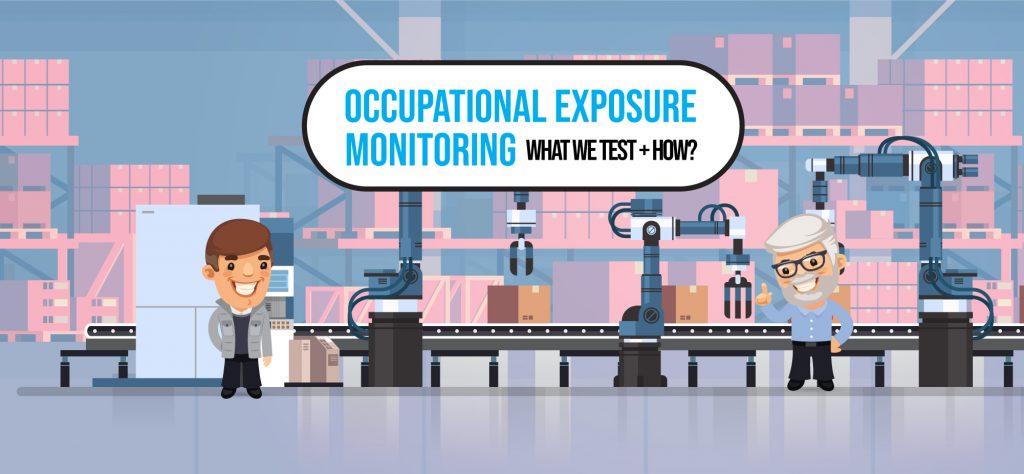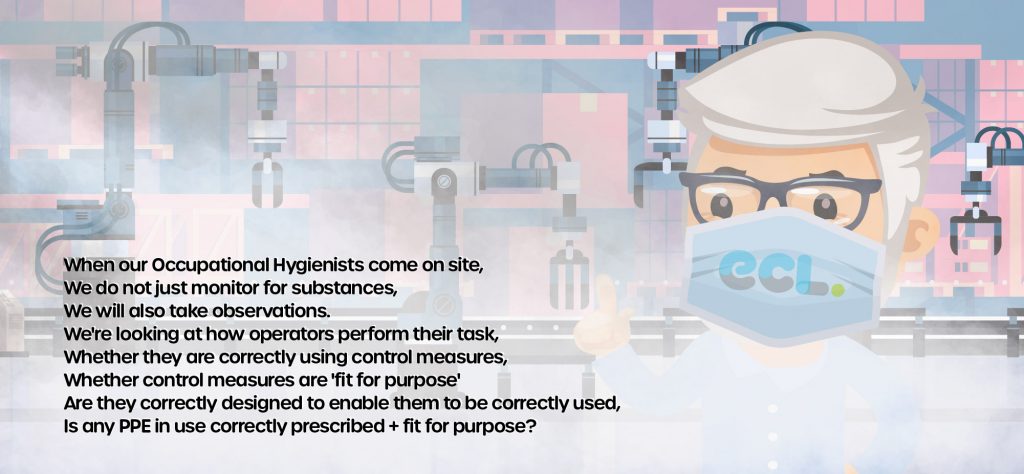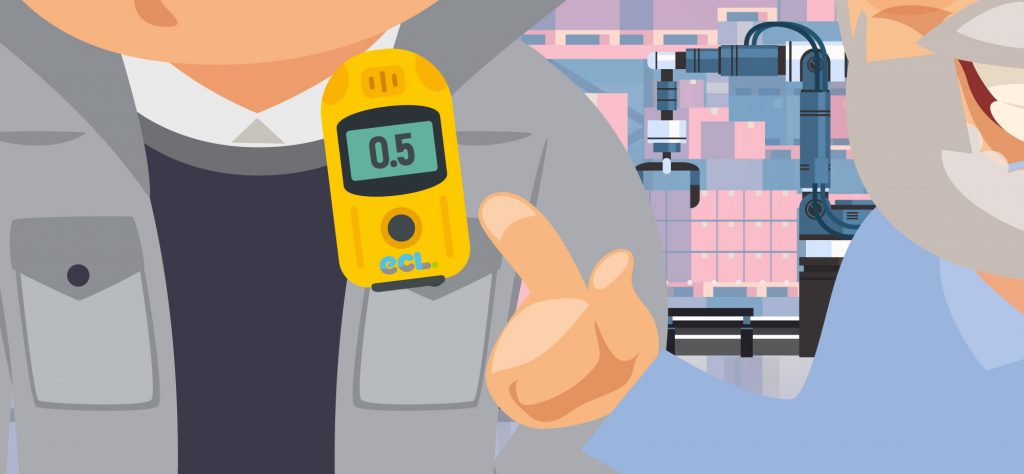What Does Occupational Exposure Monitoring Test For?
When undertaking occupational exposure monitoring, we are often required to test for a variety of chemical agents.
In most industries, we are exposed to some sort of chemical agent or agents.
As an employer you are required to control these under COSHH. So, it is important to identify and manage the risks associated with these chemical agents in the workplace.

But first it is important to think about the forms of these agents, which come in three basic states. These states are:
Solids – These can often be swallowed.
Liquid – These can be absorbed through the skin or could be injected or ingested into the body.
Gas – These are likely to be breathed in.
Another form of chemical agent is aerosols. An aerosol is a fine solid or liquid particles suspended in air. These can behave in a similar manor as gas and the size of the particle can determine how far into the respiratory tract the particle can travel.
Here are a few different types of aerosol particles:
Dust – This is a solid inanimate particle that can be produced from grinding, crushing, sanding or milling. Generally particles larger than 75 micrometres are unlikely to remain airborne. Particles that enter the nose and mouth are termed Total Inhalable Dust. The particles that are able to enter into the lungs are known as Respirable Dust and are usually 0.5 micrometres to 7 micrometres. We have more Information in our Silica Dust Exposure and Monitoring article.
Fibres – These tend to have a ratio of at least 1:3. These can be natural minerals like asbestos, natural materials like cotton and jute or man-made mineral fibres.
Fumes – These are formed by the vaporisation or oxidation of molten metal for examples MIG Welding Fume.
Mists – These are liquid droplets that can be created by spraying, pickling, foaming and electroplating
Smoke – This is a collection of airborne particles emitted when a material undergoes combustion
If your workplace creates any of these substances, there could be a need to undertake Occupational Exposure Monitoring to ensure your employees are safe.

How Is Occupational Exposure Monitoring Done?
Employers, have a duty of care towards their employees to ensure they are kept safe and healthy. One way of doing this is by performing occupational exposure monitoring. But how is this done and why?
Why Perform Occupational Exposure Monitoring?
It is important to monitor substances that are hazardous to health because:
- Until the concentration in air is known it is not practical to gauge the level of control required
- Control measures can fail and could cause serious health effects
- It can demonstrate the WEL is not being exceeded
- It can prove the effectiveness of the control measures in place
- Any changes in the workplace could affect employees’ exposures.
Observations
When our Occupational Hygienists come on site, they do not just monitor for substances, they will also take observations. These observations for example, can involve looking for dust particles in the air using dust lamps, which makes small particles often too small to be seen by the naked eye, visible.
We look at the control measures in place. In addition, they can perform a Thorough Examination and Test of Local Exhaust Ventilation systems (LEV) to ensure it is meeting the legal requirements stated in HSG 258.
We’re also looking at how operators perform their task, whether they are correctly using control measures, whether control measures are ‘fit for purpose’ (i.e. are they correctly designed to enable them to be correctly used), is any PPE in use correctly prescribed & fit for purpose (and used correctly) etc…
Our experienced consultants will look at how employees are handling any hazardous substances and how they could be potentially exposed.
Observations are an important aspect of occupational exposure monitoring and any issues can often be found by taking observations. However, to re-affirm these observations, our experts also sample for the hazardous substance itself.
Sampling of Hazardous Substances
Our experts make several key choices, which determine the correct approach to sampling every hazardous substance.
The first choice being, whether to take a short-term sample or a long-term sample.
The difference being:
- A short-term sample is normally taken as a comparison with a 15-minute exposure limit when dealing with substances with acute effects. The sample of air is taken for identification of the contaminant and a comparative idea of its concentration in the air at that time.
- A long-term sample, samples air over a period of time, (sometimes using a calibrated pump to draw a known volume of air, however passive sampling is also used.) This allows our experts to calculate a time-weighted average (TWA) concentration, which can be compared to the Workplace Exposure Limit (WEL)
Long-term sampling techniques use personal samplers or static (environmental) samplers. Personal samplers measure the specific concentrations an individual may be exposed to. Static samples are positioned in the workplace and provides a measure of general workplace airborne contamination over time.
Sampling equipment may be direct reading or indirect reading. Direct reading equipment gives an immediate reading, these can be stain detector tubes and more sophisticated equipment such as a Flame-Ionisation Detector (FID). Indirect reading equipment requires a sample to be taken to a laboratory for analysis.
Air sampling can be done either passively or actively. Passive air sampling allows air to diffuse over a sampling media, which may be a badge or dosimeter tube. Active sampling tends to use a calibrated air pump to draw a known volume of air over the sampling media over a known period of time.
Personal Dust Monitoring
A more common test our experts undertake is personal dust monitoring. This involves our experts attaching a sampling head within the wearers breathing zone, which is connected by a tube to a calibrated pump.
A pre-weighed filter is placed in the sampling head. Air is drawn through the filter at a known rate, over a known period of time. The filter is then sent to the laboratory for analysis, where the filter is re-weighed and the difference determines the mass of the contaminant. The mass is then divided by the volume of air sampled to give the wearers exposure.

We Help You Through The COSHH Process
After undertaking occupational exposure monitoring, the next stage of the COSHH Air Monitoring process may be to carry out health surveillance.
We have more information on the COSHH Process below:
- COSHH Risk Assessment.
- Decide the required precautions.
- Prevent or adequately control exposure.
- Ensure maintenance of control measures.
- Monitor exposure.
- Carry out Health Surveillance.
- Prepare emergency procedures.
- Ensure all employees are adequately trained.
Your Occupational Exposure Monitoring Experts
ECL offer Occupational Exposure Monitoring services to monitor air quality at work.
Our consultants are members of the British Occupational Hygiene Society (BOHS) and can also offer you a thorough examination and testing of your control measures including LEV Testing and Workplace Noise Assessments.
Contact us via our Enquiry Form or call us on 01443 841760 for any queries regarding our wide range of Environmental Consultancy, Air Monitoring, Occupational Hygiene or COSHH compliance services.